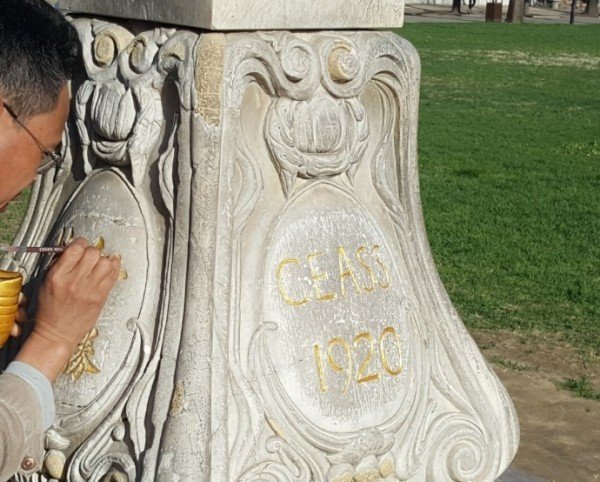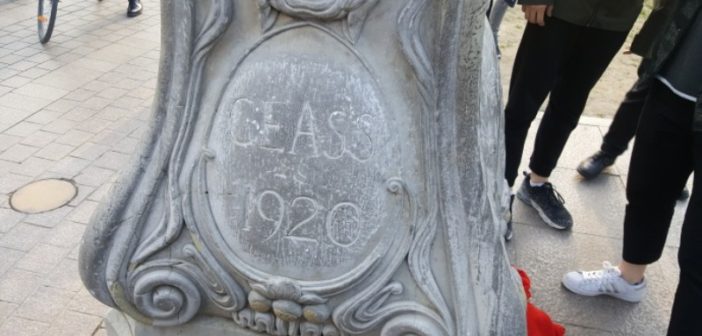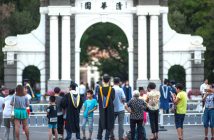Since its founding in 1911, Tsinghua University has built up a storied legacy that has seen it become nothing less than the top engineering and computer science school in the world. But for all of the school’s bright minds, English fluency doesn’t appear to be a primary concern after one of its famous landmarks has been revealed to include a spelling mistake that went uncorrected for years.
Tsinghua officials admitted yesterday that a spelling mistake made on its nearly century-old sundial has been rectified, reported Beijing Youth Daily.

The sundial as it now appears
The correction was made after a worker was seen writing out the words “CEASS 1920” in the inlaid inscription of the sundial base last week instead of “CLASS 1920”, a reference to the Tsinghua graduated students who commissioned the sundial for their alma mater.

Either work hard, or you’re hardly working
A student named Hu noticed the mistake and posted photos of the mislabeled sundial online (shown above). When he confronted the worker about it, the worker simply said he doesn’t read English and was only following the inscription that was already set into the sundial.
READ: Beijing Health Authority Quotes Same Smoking Statistic Two Years in a Row, No One Notices
At some time in its history, someone vandalized the sundial by adding two extra marks to the capital “L”, turning it into a capital “E”. As mysterious as the way in which the sundial was vandalized, even stranger is how that vandalization had become a normal and accepted fixture on Tsinghua University campus.
In 2015, Tsinghua’s official Weibo account posted this photo that clearly shows the sundial inscription reading “CEASS” (shown below).

Praising Tsinghua’s prestigious history in 2015
And in 2011, this Weibo user posted photos of the English error with a post that asked: “Won’t this well-admired university finally admit this mistake?” (shown below)

yanyan888’s post received no upvotes back in 2011
It gets worse: Beijing Youth Daily reports the English error can be traced back to at least 2007. Even though it makes no sense in English, the vandalization persisted for years at the school largely considered to be home to China’s brightest minds.
READ: Beijing Officials Admit Artifacts Stolen From Famous Ming Tomb… One Year Later
That is, until now. After the vandalized inscription was officially “set in stone” with the gold paint, Tsinghua finally read the writing on the wall once Hu posted photos of the English error to his Weibo account last week.

Nothing is written in stone
Tsinghua’s English flub coincides with a current city-wide contest soliciting corrections for Beijing’s numerous poorly-translated English signs.
A glaring lack of English fluency has been demonstrated before at China’s top school. In 2016, Tsinghua University temporarily shut down a da Vinci exhibit at its art museum when it was revealed to contain glaring English mistakes such as “The Last Super.”
Tsinghua University remains a popular tourist destination that regularly gets defaced by visitors who scrawl things like “I will return” upon school landmarks such as its iconic gates and bell. But despite being a common occurrence, “CEASS” has managed to escape detection even though a sundial deface that happened last summer sparked a public outcry.
For its part, Tsinghua University says it has no plans to erect a barricade to sequester the famous sundial away from a public intent on taking photographs with it. If they did, people might not see the irony of the sundial’s inherent message.
Written in Chinese (“行胜于言”) and Latin (“facta non verba”), the sundial is unfortunately inscribed with the message “Deeds, not words”… when it was an ignorance of “words” that led to this decade-long gaff.

Maybe it’s time to surround the sundial with a fence… like it was originally
More stories from this author here.
E-Mail: charlesliu1 (at) qq (dot) com
Twitter: @Sinopath




